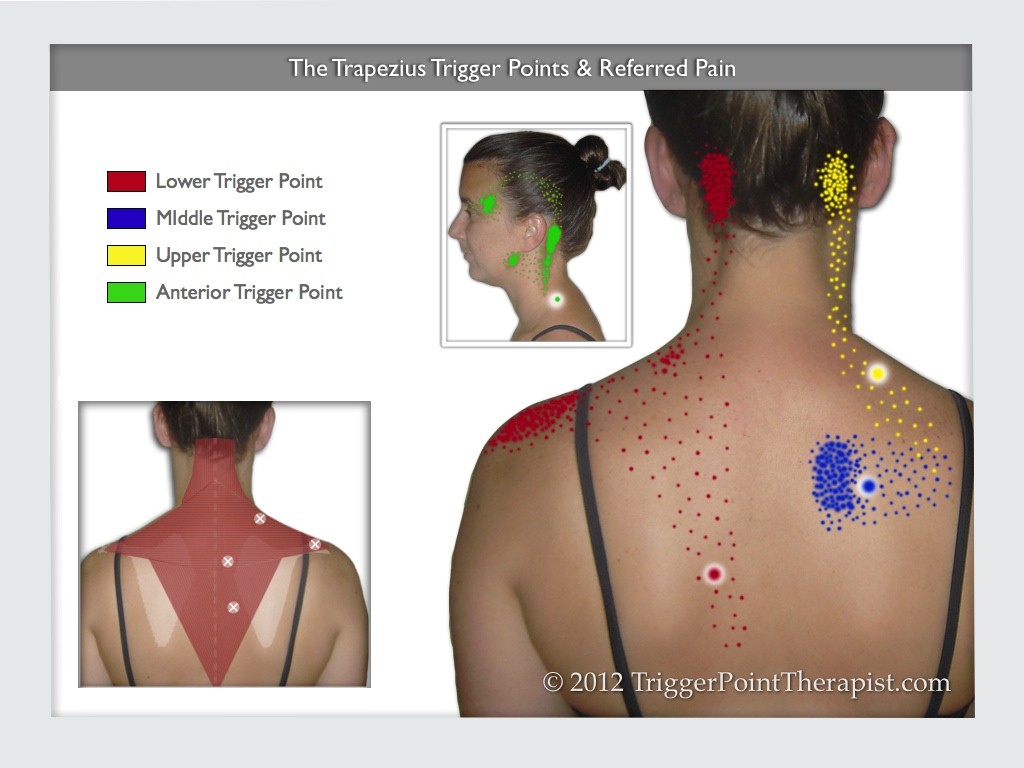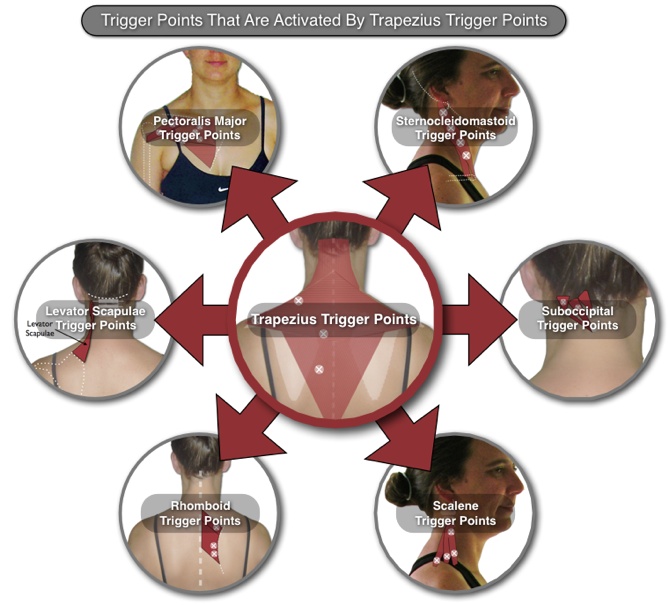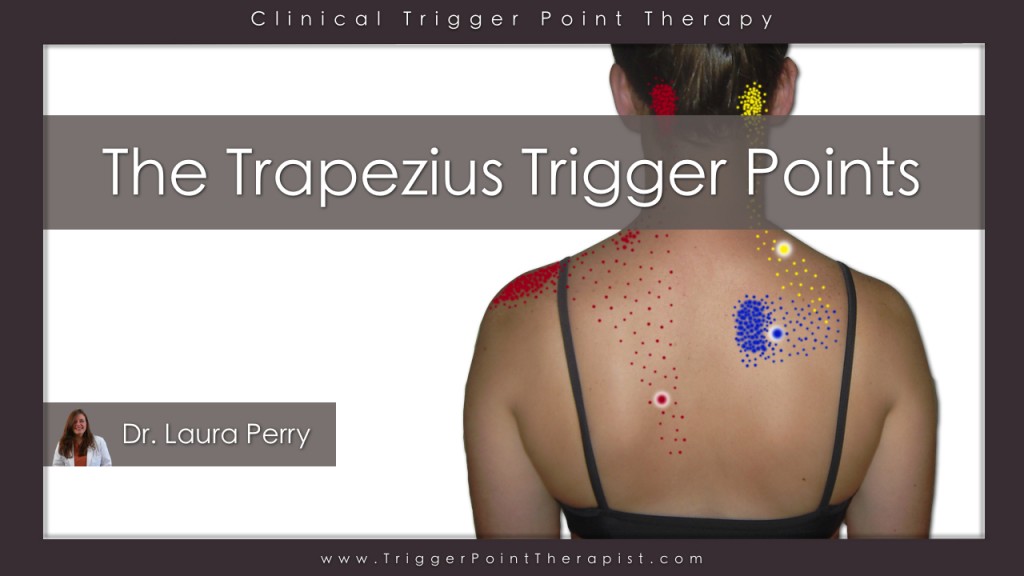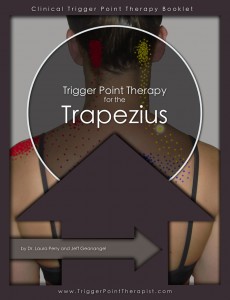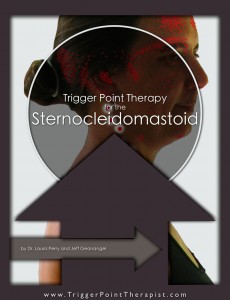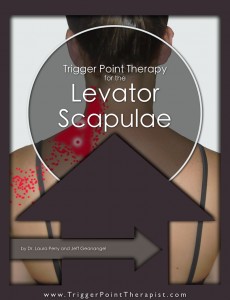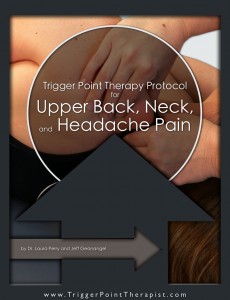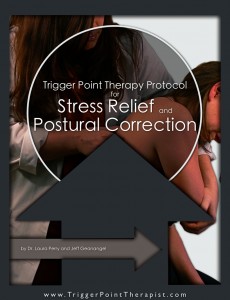No joke, in all my years as a trigger point therapist, I’ve never failed to find at least one trapezius trigger point on a client. I don’t really know if this is a good or bad thing, but I do know that if you want to practice trigger point therapy at any level, you need to know these trigger points inside and out.
The Trapezius Muscle: More than Meets the Eye…or Fingers
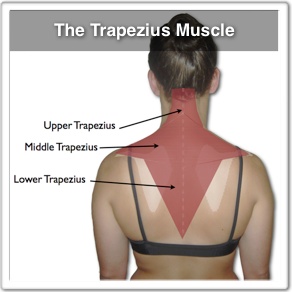 The first thing that a trigger point therapist should know is that the trapezius is not one, but three separate muscles: the upper trapezius, the middle trapezius, and the lower trapezius. All three trapezius muscles originate along the spine and extend laterally to attach to the shoulder girdle, but each muscle has a different fiber direction and pull.
The first thing that a trigger point therapist should know is that the trapezius is not one, but three separate muscles: the upper trapezius, the middle trapezius, and the lower trapezius. All three trapezius muscles originate along the spine and extend laterally to attach to the shoulder girdle, but each muscle has a different fiber direction and pull.
The way in which all three muscles work together to create various movements of the shoulder blade, neck, and head is quite intricate. For example, the simple act of flexing the head to the right requires:
- Contraction of the lower trapezius on the right side to fix the right shoulder blade in place.
- Contraction of the right upper trapezius to pull the neck and head to the right.
- Relaxation of the left lower trapezius to allow the left shoulder blade to rise.
- Relaxation of the left upper trapezius to allow the neck and head to move to the right.
From this example we can see that trapezius muscle group is like an orchestra, with one part dependent on all the other parts to perform properly. This type of complexity makes it easy for trigger point activity to spread quickly through the muscle group as a whole.
The Trapezius Trigger Points and Referred Pain
There are four primary trigger points in the trapezius muscle group; two trigger points in the upper fibers, and one each in the middle and lower fibers. Let’s begin with the basics for each of these trigger points, and then will get more specific.
- The anterior trapezius trigger point lies in the near vertical fibers of the upper trapezius that attach to the clavicle. It refers pain to the side of the neck and up into the temple region of the head.
- The upper trapezius trigger point lies in the more horizontal fibers of the upper trapezius on the back of the shoulder, about halfway between the tip of the shoulder and the spine. The referred pain from this trigger point projects strongly to the back of the neck near the occiput, and travels down the back of the neck into the shoulder region.
- The middle trapezius trigger point lies within the horizontal fibers of the middle trapezius. As this trigger point can develop within any of the middle trapezius fibers, its position can vary vertically along the inside edge of the shoulder blade. The referred pain from this trigger point does not project far, and is typically experienced in the local region.
- The lower trapezius trigger point lies within the lower trapezius fibers and is found a few inches medial to the lower half of the shoulder blade. The hallmark of this trigger point is its referred pain to the tip of shoulder joint, near the AC joint. This trigger point is extremely common and is responsible for the “weight of the world on my shoulders” feeling that we are all familiar with.
Talk About a Pain in the Neck!
There is a reason that the expression “pain in the neck” is so widely used; it’s the truth. The mental and emotional stress of modern day life is not just in your head, it often takes physical form as trigger points in the lower and upper trapezius muscles.
The lower trapezius trigger point is the most sensitive to psychological stress (see The Lower Trapezius Trigger Point: A.K.A. the “Bitchy” Point), and projects pain and tenderness upward into the neck and shoulder region. The pain from the lower trigger point activates the upper trigger point, which results in another layer of pain referred to the posterior neck region. With two trigger points involved, the tension and pain in the neck becomes unbearable, but unfortunately in most cases this is only the beginning.
Not Tonight Honey, I Have Trapezius Trigger Points
Once the upper trapezius trigger point is involved, the anterior trigger point usually not far behind. This trigger point refers pain to the side of the neck, jaw, and face, but it is notorious for producing a throbbing headache in the temple region. This headache pain may also be described as “behind the eye.”
It’s important to emphasize that in a situation like this, just releasing the anterior trigger point is futile, because it will be quickly reactivated by unaddressed upper and lower trapezius trigger points. If you were to only release one trapezius trigger point on a headache pain client, you would be better off focusing on the lower trigger point, even though it does not directly cause headache pain.
Burning Pain Between the Shoulder Blades
One exception to the “come one, come all” nature of the trapezius trigger points is the activity of the middle trapezius trigger point, which produces a localized burning-type pain along the spine. For the most part, this trigger point occurs independently of other trigger points in the trapezius muscle group, but it will often recruit the rhomboid trigger points as they share a similar intra-scapular pain pattern.
Another target for middle trapezius referred pain is the multifidi trigger points in the thoracic spine region, which are responsible for creating articulation dysfunctions in the facet joints of the spine.
But these aren’t the only muscle groups affected by trigger point activity in the trapezius muscle group, as we will see below.
Trapezius Trigger Points: Gateway Drug for Upper Body Pain
I jokingly refer to the trapezius trigger points as the “gateway drug” of upper body pain because they often lead to more serious pain complaints involving trigger points in multiple muscle groups. The diagram below shows some of the more common of these interactions.
You can now see why I believe every trigger point therapist, whether they are professional or layman practitioners, should be experts on the trigger points in the trapezius muscle; they are involved with too many myofascial pain disorders to not take seriously.
The Pectoralis-Trapezius Connection
One the interactions in the diagram above deserves special mention here. The rounded shoulder-sunken chest posture that many of us adapt when sitting at the computer or reading for long periods of time, has a tendency to cause simultaneous trigger point activity in the middle trapezius and pectoralis major muscle. Because of this strong antagonistic and postural relationship, it becomes nearly imposiible to effectively treat the trapezius trigger points without also treating the pectoralis major trigger points.
The Calf-Trapezius Connection
Trapezius trigger points have a connection with another muscle group that I’m afraid I’m at a loss to explain. Over the years, I have noticed that many of my clients with trapezius trigger points also suffer from soleus trigger points in their lower leg. Other than an extremely rare trigger point in the soleus muscle that can refer pain to the ipsilateral jaw and face, I don’t know any reasons why these two muscle groups should be clinically linked in this manner. Nonetheless, in cases where the release of the trapezius trigger points proves too painful for the client, I find if I release the calf trigger points first, my trapezius work becomes more easily tolerated by the client.
The Sternocleidomastoid-Trapezius Connection
One final connection that I must highlight, is the propensity of trigger point activity in the upper trapezius to ignite the sternocleidmastoid trigger points. I use the term ignite here because when this occurs a client’s headache can go from an annoying throbbing at the temple to an incapacitating migraine-type presentation. And trust me on this, don’t put the client through the discomfort of treating their sternocleidomastoid trigger points if you haven’t cleared their trapezius muscle first.
Learn How To Release The Trapezius Trigger Points Today
Do yourself, your clients, and your loved ones a huge favor by learning how to recognize, locate, and release the trapezius trigger points. If you want help with this, my Trigger Point Video for the Trapezius Muscle will provide you with step-by-step instructions for locating and releasing the four trapezius trigger points.
Got an iPad? You can now purchase the Trigger Point Therapy for the Trapezius Booklet for the iPad on the iBookstore.
Who knows, if enough people learn how to deal with these trigger points, maybe I will finally get to see a client who doesn’t have some sort of trapezius issue.
Click on the image below to watch an excerpt from the Trapezius Trigger Points video on YouTube:
Related Articles:
- The Lower Trapezius Trigger Point: A.K.A the “Bitchy” Point
- Sternocleidomastoid Trigger Points: Masters of the Migraine
- Levator Scapulae Trigger Points: Frankenstein Pain
- Pectoralis Major Trigger Points: The Cardiac Copycats
- Gastrocnemius Trigger Points: The Calf Cramp Trigger Points
Related Instructional Videos:
